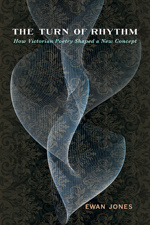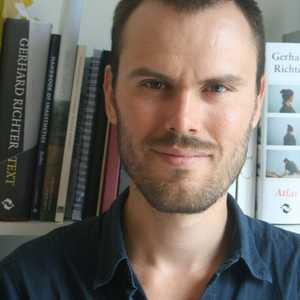Today, we are happy to bring you our conversation with Ewan Jones, author of The Turn of Rhythm: How Victorian Poetry Shaped a New Concept.
What inspired you to write this book?
I’ve long been obsessed with the often technical and recondite field of prosody. From my doctoral dissertation, I’ve tried to find ways to connect the specific structure and experience of verse rhythm to broader concerns. My first book, Coleridge and the Philosophy of Poetic Form (Cambridge UP, 2014), did this for a single figure. But my sophomore effort found me hankering – like many before me – for a larger canvas. As a historian of eighteenth- and nineteenth-century poetry, I’ve long held the intuition that something fundamental changed in the discourse around rhythm at this critical juncture. But it wasn’t until I began working on a collaborative project, which conducted computational analysis of large datasets, that I obtained a quantitative metric of this shift. Put crudely, the word rhythm is almost totally absent from anglophone discourse, prior to 1780. Even if some concept of rhythm existed without the word, I found this remarkable. The Turn of Rhythm tells the story of the sudden emergence of its central notion.
What did you learn and what are you hoping readers will learn from your book?
During my research, I became happily side-tracked in a variety of fields (ranging from ethnomusicology to the thermal sciences), which I would never previously have imagined myself exploring. These varied discourses compounded my sense that poetry played an influential role in the broader development of rhythm – not just because scientists or philosophers referred to examples of verse, but also because verse conducted a specific form of non-discursive embodied thinking. By the end of its long gestation, the monograph had taken on a very different aspect to that which I had foreseen – in addition to trying to capture the phenomenological colour of reading poets such as Robert Browning, Alice Meynell and A. C. Swinburne, I also found myself investigating the rhythms of maternity, of simple unicellular organisms, and of the entropic universe.
What surprised you the most in the process of writing your book?
As a verse obsessive, I am accustomed to finding poetry in unlikely places. Even with my knowledge of the historical period, however, I was amazed at the extent to which the medium penetrated all aspects of intellectual life. From the deep interpenetration of early institutional forms of literary criticism and speech therapy (where poetry was called upon as a means of curing stuttering), to the deep interest of scientists such as William Whewell and J. C. Maxwell in poetic form, verse rhythm offered an unparalleled means of resolving pressing social and theoretical questions. I was also positively surprised by less canonical poems, whose quality and sophistication I’d previously overlooked. George Eliot’s The Spanish Gypsy, and Alice Meynell’s deceptively compliant lyrics and sonnets prove cases in point. While a modernist such as Woolf defined herself self-consciously in opposition to the genteel tradition that she took Meynell to represent, I chart a number of unlikely rhythmical echoes in the later author’s work. Finally, I continued to be positively surprised by the brilliance of my students, in dialogue with whom many of the book’s fundamental ideas were developed.
What’s your favorite anecdote from your book?
My research revealed an anecdote that I found particularly fascinating. It concerns the biological concept of entrainment – the tendency for organisms to synchronise to an external phase. Once you’ve learned this idea, you start to see it everywhere – in the finger-tapping of the audience of a jazz concert, in the communal speech patterns of the students in your seminar. There’s a longstanding debate in evolutionary biology as to which organisms demonstrate such a capacity. While many claim that entrainment is restricted to humans (or to language learners), I also discovered a controversial study, in which a rooster gained celebrity for its ability to screech rhythmically to a track by the Backstreet Boys. (The rooster’s response to other boy bands is not noted.) Underlying this little story is a serious question regarding the limits of the human and nonhuman animal.
What’s next?
I continue to be obsessed with the question as to how to relate local aesthetic experience to broader human questions. While I remain deeply interested in questions of prosody and rhythm, I’ve recently been delving into the voluminous literature on attention, which I think represents an excellent way to relate what our discipline continues to call ‘close reading’ to contemporary research in psychology and philosophy of mind. To this end, I’m editing (with Marion Thain) a set of collected essays entitled Close Reading as Attentional Practice. Over the longer term, we hope to encourage interdisciplinary dialogue within what we loosely call ‘attention studies’ – a topical concern, given pressing concerns over digital cultures of distraction. I would also like to write a book addressing pedagogy, which brings together a series of experimental teaching protocols that I’ve been developing over the past years (partly through the necessity of lockdown). Last but not least, I’m translating the popular reality TV show Love Island into poetry (using Pushkin’s Eugene Onegin stanza form) – on the conviction that one cannot be a scholar of rhythm, without giving oneself up to rhythm.





